Abstract
Human lymph was collected from patients with leaking lymph vessels after thoracic surgery. Ovine lymph was obtained from the mesenteric, lumbar, popliteal and prescapular lymph ducts by cannulation. The concentration of hyaluronate varied considerably (between 0.2 and 50 mg/l) and the highest concentrations were found in mesenteric lymph. The Mr of the polysaccharide showed a great polydispersity and variation between individuals and in different regions of the lymphatic system. High-Mr hyaluronate (greater than 10(6) was present in lymph both from man and sheep. Hyaluronate was also isolated by affinity chromatography in 70-80% yield from human serum and plasma obtained from healthy individuals and patients with rheumatoid arthritis and primary biliary cirrhosis. The weight (Mw)- and number (Mn)-average relative molecular masses were roughly the same in the three groups [(1.4-2.7) X 10(5) and (2.1-5.7) X 10(4) respectively]. The low Mr of hyaluronate in blood compared with that in lymph is explained by a preferential uptake of the large molecules by the liver endothelial cells.
Full text
PDF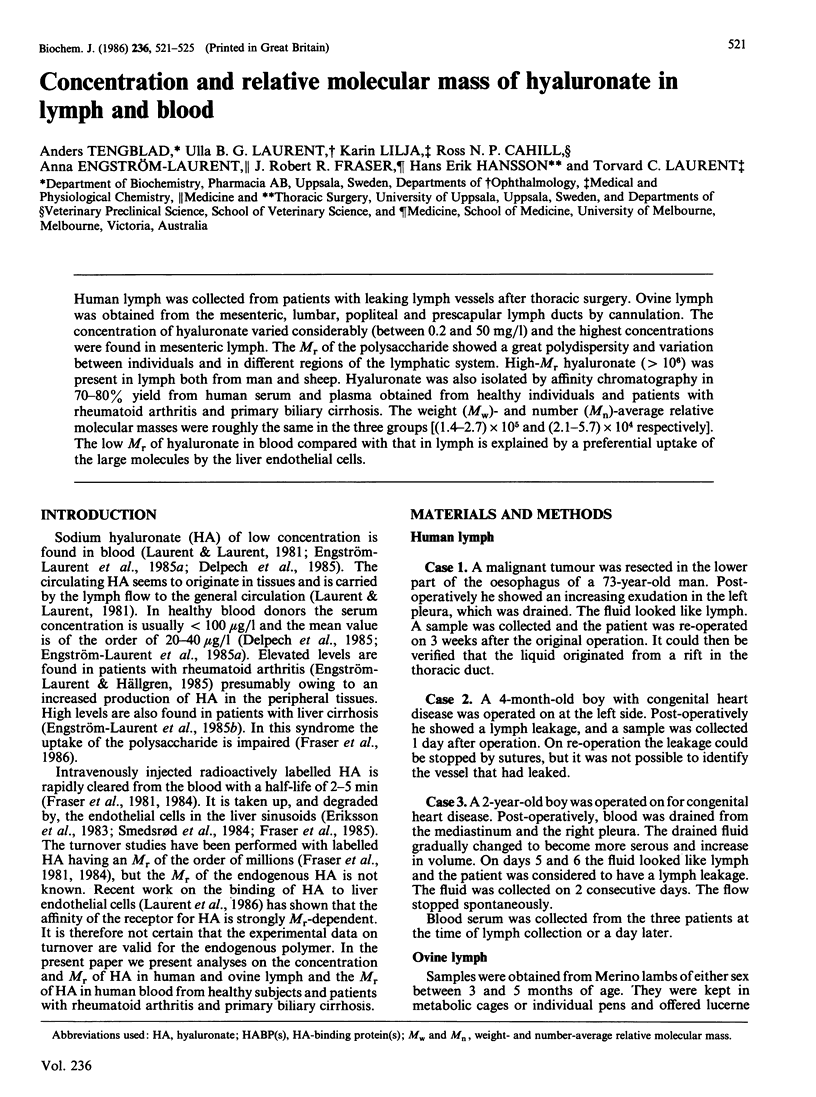
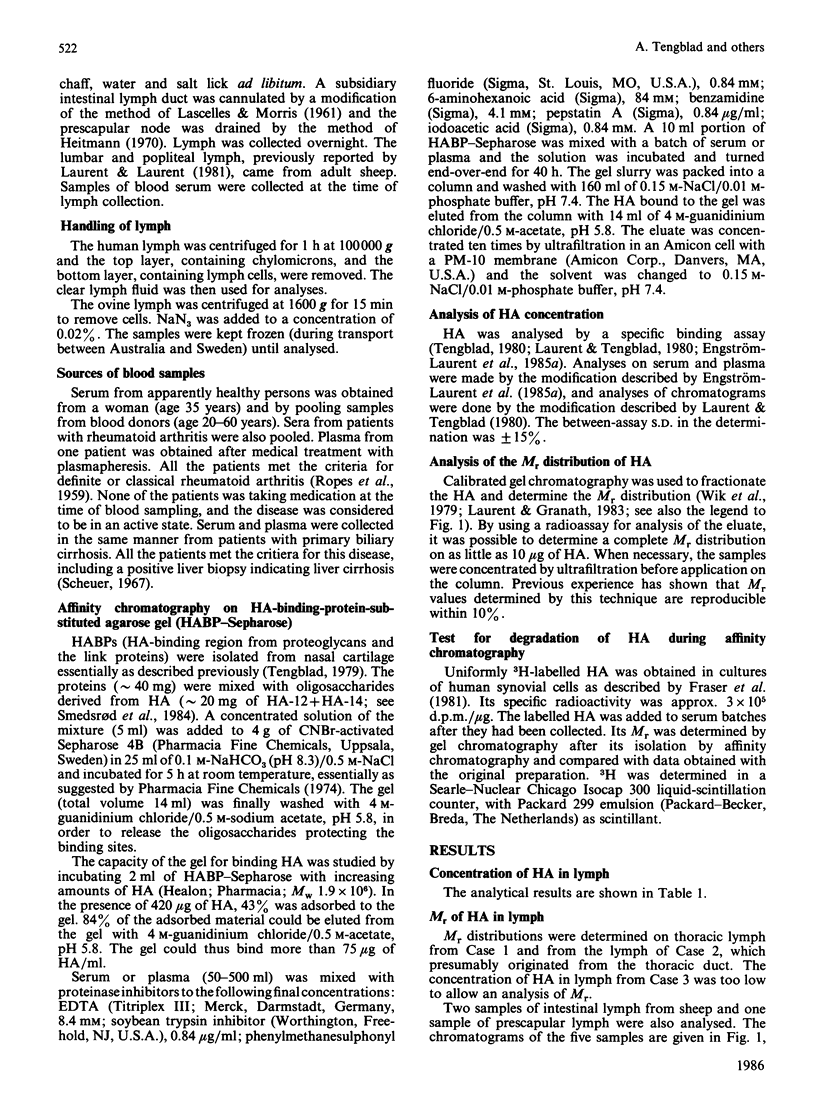
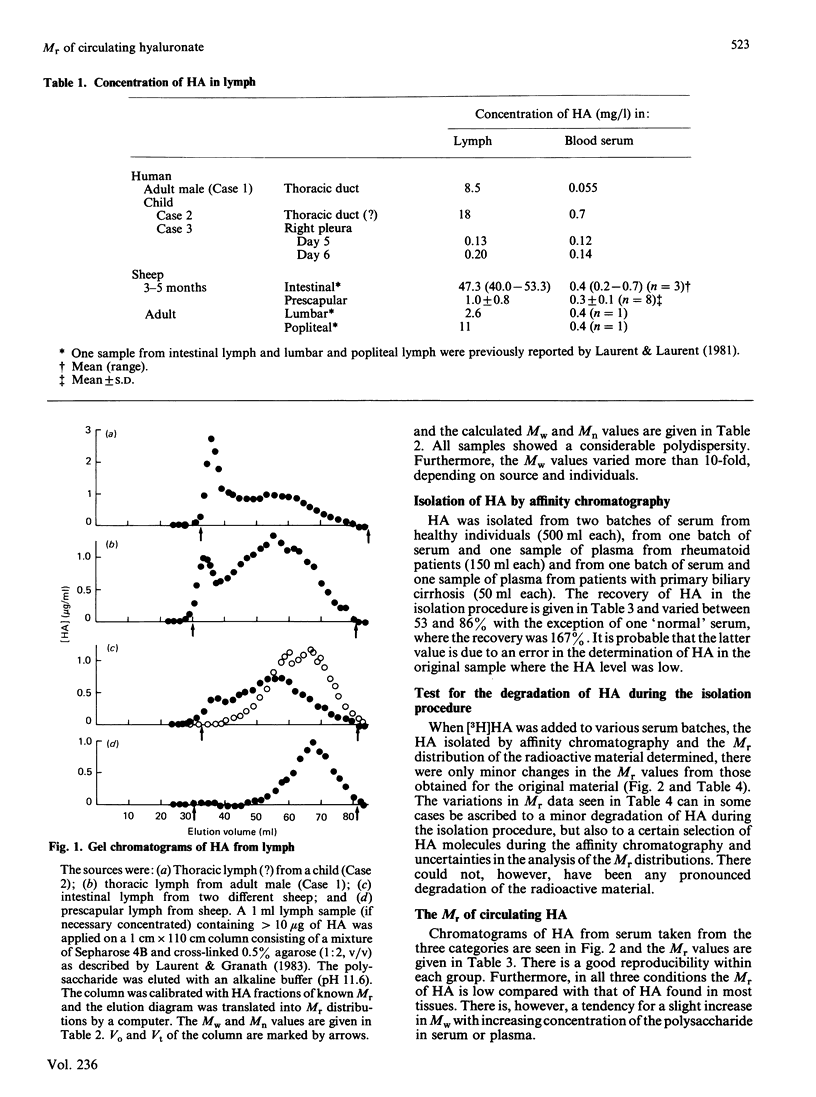
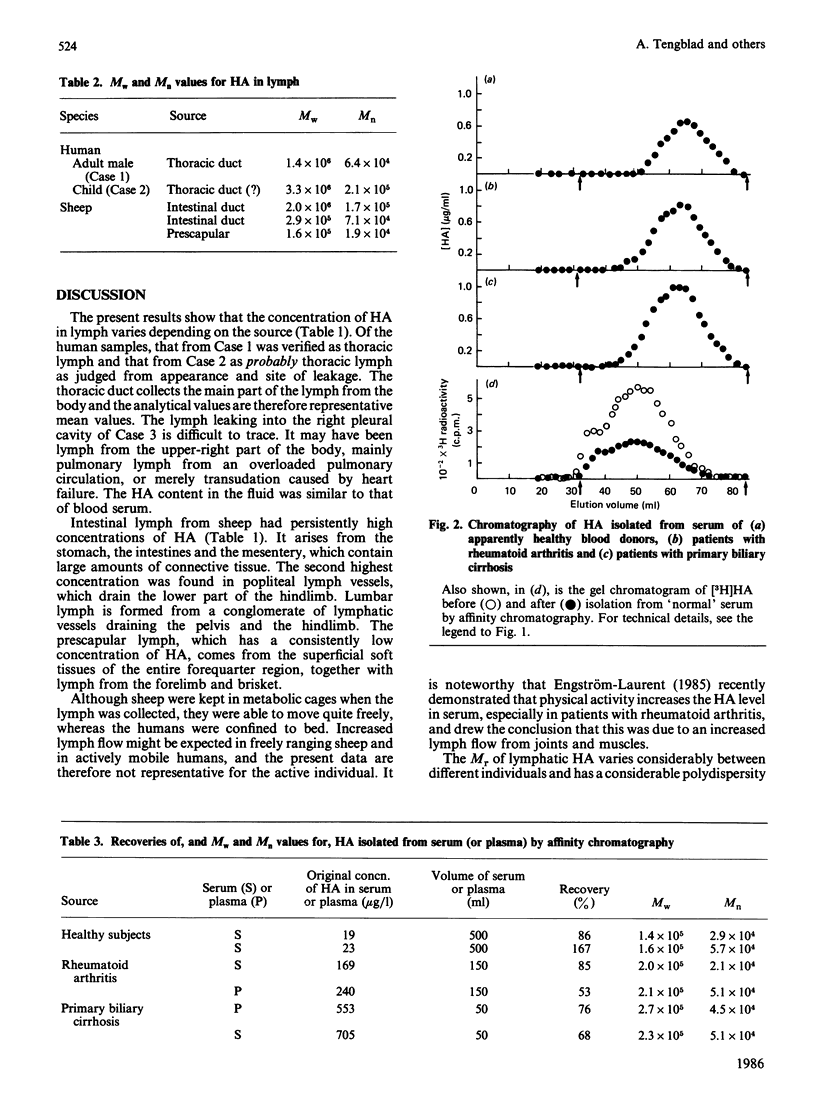
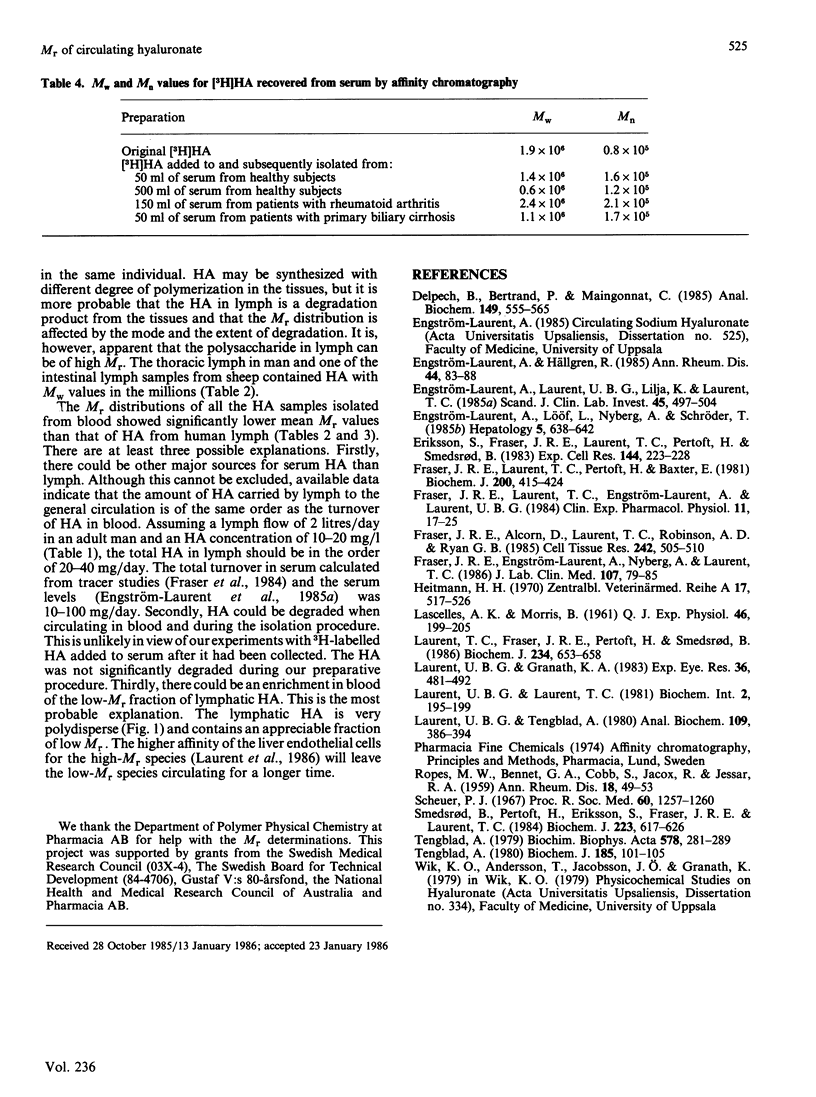
Selected References
These references are in PubMed. This may not be the complete list of references from this article.
- DIAGNOSTIC criteria for rheumatoid arthritis: 1958 revision by a committee of the American Rheumatism Association. Ann Rheum Dis. 1959 Mar;18(1):49–53. [PMC free article] [PubMed] [Google Scholar]
- Delpech B., Bertrand P., Maingonnat C. Immunoenzymoassay of the hyaluronic acid-hyaluronectin interaction: application to the detection of hyaluronic acid in serum of normal subjects and cancer patients. Anal Biochem. 1985 Sep;149(2):555–565. doi: 10.1016/0003-2697(85)90613-x. [DOI] [PubMed] [Google Scholar]
- Engström-Laurent A., Hällgren R. Circulating hyaluronate in rheumatoid arthritis: relationship to inflammatory activity and the effect of corticosteroid therapy. Ann Rheum Dis. 1985 Feb;44(2):83–88. doi: 10.1136/ard.44.2.83. [DOI] [PMC free article] [PubMed] [Google Scholar]
- Engström-Laurent A., Laurent U. B., Lilja K., Laurent T. C. Concentration of sodium hyaluronate in serum. Scand J Clin Lab Invest. 1985 Oct;45(6):497–504. doi: 10.3109/00365518509155249. [DOI] [PubMed] [Google Scholar]
- Engström-Laurent A., Löf L., Nyberg A., Schröder T. Increased serum levels of hyaluronate in liver disease. Hepatology. 1985 Jul-Aug;5(4):638–642. doi: 10.1002/hep.1840050420. [DOI] [PubMed] [Google Scholar]
- Eriksson S., Fraser J. R., Laurent T. C., Pertoft H., Smedsrød B. Endothelial cells are a site of uptake and degradation of hyaluronic acid in the liver. Exp Cell Res. 1983 Mar;144(1):223–228. doi: 10.1016/0014-4827(83)90458-5. [DOI] [PubMed] [Google Scholar]
- Fraser J. R., Alcorn D., Laurent T. C., Robinson A. D., Ryan G. B. Uptake of circulating hyaluronic acid by the rat liver. Cellular localization in situ. Cell Tissue Res. 1985;242(3):505–510. doi: 10.1007/BF00225415. [DOI] [PubMed] [Google Scholar]
- Fraser J. R., Engström-Laurent A., Nyberg A., Laurent T. C. Removal of hyaluronic acid from the circulation in rheumatoid disease and primary biliary cirrhosis. J Lab Clin Med. 1986 Jan;107(1):79–85. [PubMed] [Google Scholar]
- Fraser J. R., Laurent T. C., Engström-Laurent A., Laurent U. G. Elimination of hyaluronic acid from the blood stream in the human. Clin Exp Pharmacol Physiol. 1984 Jan-Feb;11(1):17–25. doi: 10.1111/j.1440-1681.1984.tb00235.x. [DOI] [PubMed] [Google Scholar]
- Fraser J. R., Laurent T. C., Pertoft H., Baxter E. Plasma clearance, tissue distribution and metabolism of hyaluronic acid injected intravenously in the rabbit. Biochem J. 1981 Nov 15;200(2):415–424. doi: 10.1042/bj2000415. [DOI] [PMC free article] [PubMed] [Google Scholar]
- Heitmann H. H. Eine Methode zur Langzeit-Sammlung der efferenten Lymphe des Buglymphknotens beim Schaf. Zentralbl Veterinarmed A. 1970 Jun;17(6):517–526. [PubMed] [Google Scholar]
- LASCELLES A. K., MORRIS B. Surgical techniques for the collection of lymph from unanaesthetized sheep. Q J Exp Physiol Cogn Med Sci. 1961 Jul;46:199–205. doi: 10.1113/expphysiol.1961.sp001536. [DOI] [PubMed] [Google Scholar]
- Laurent T. C., Fraser J. R., Pertoft H., Smedsrød B. Binding of hyaluronate and chondroitin sulphate to liver endothelial cells. Biochem J. 1986 Mar 15;234(3):653–658. doi: 10.1042/bj2340653. [DOI] [PMC free article] [PubMed] [Google Scholar]
- Laurent U. B., Granath K. A. The molecular weight of hyaluronate in the aqueous humour and vitreous body of rabbit and cattle eyes. Exp Eye Res. 1983 Apr;36(4):481–492. doi: 10.1016/0014-4835(83)90042-8. [DOI] [PubMed] [Google Scholar]
- Laurent U. B., Tengblad A. Determination of hyaluronate in biological samples by a specific radioassay technique. Anal Biochem. 1980 Dec;109(2):386–394. doi: 10.1016/0003-2697(80)90665-x. [DOI] [PubMed] [Google Scholar]
- Scheuer P. Primary biliary cirrhosis. Proc R Soc Med. 1967 Dec;60(12):1257–1260. [PMC free article] [PubMed] [Google Scholar]
- Smedsrød B., Pertoft H., Eriksson S., Fraser J. R., Laurent T. C. Studies in vitro on the uptake and degradation of sodium hyaluronate in rat liver endothelial cells. Biochem J. 1984 Nov 1;223(3):617–626. doi: 10.1042/bj2230617. [DOI] [PMC free article] [PubMed] [Google Scholar]
- Tengblad A. Affinity chromatography on immobilized hyaluronate and its application to the isolation of hyaluronate binding properties from cartilage. Biochim Biophys Acta. 1979 Jun 19;578(2):281–289. doi: 10.1016/0005-2795(79)90158-2. [DOI] [PubMed] [Google Scholar]
- Tengblad A. Quantitative analysis of hyaluronate in nanogram amounts. Biochem J. 1980 Jan 1;185(1):101–105. doi: 10.1042/bj1850101. [DOI] [PMC free article] [PubMed] [Google Scholar]


